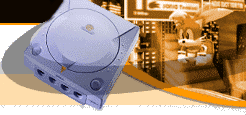| |
Grandia 2
Looking for a hot DC RPG? Game Arts and Ubi Soft have you covered - by BenT
Game Arts' Grandia for the Sega Saturn was one of the most hyped non-Square RPGs of the 32-bit era, and it wasn't without reason; the game was, in a word, grand. Some people went so far as to call it the "Final Fantasy 7-killer", and the game did indeed surpass Square's blockbuster in some areas. However, this was 1997, the height of Sega of America's incompetence. True to form, they managed to drop the ball in their typically spectacular fashion, and Grandia never saw a Saturn release outside of Asia. Luckily for RPG fans, Sony stepped up to the plate and brought the PlayStation port to America in 1999. The translation and localization pretty much sucked, but hey, beggars can't be choosers, right?
When the news broke that Game Arts was working on a Dreamcast-based sequel, fans were understandably excited. Finally, the Dreamcast would be getting the A-list RPGs it needed. Given the notoriety the first game accrued, it's not surprising that Ubi Soft decided to snatch up and publish Grandia 2 in the West. Believe it or not, they actually had to fight Eidos for the rights -- an indication of just how popular RPGs are these days. Yes, things have certainly changed a lot since 1997.

RPG characters love to camp. |
The game's story takes place in a world that is straddled by a huge rift, which was supposedly created thousands of years ago during a mighty battle between the gods Granas and Valmar. Your character is named Ryudo (although the names may change in the translated version), and he's your typical RPG teenager / vagabond / bodyguard-for-hire. His most recent assignment is to guard a young lady by the name of Elena, a priestess in the local religious cult. The mission is to escort her to a ceremony that may help to banish the evil Valmar, who is believed to be stirring from his age-long slumber. Of course, said ceremony goes horribly awry, and thus Ryudo's epic adventures begin.
Sound a bit like the plot of Grandia? You're right, it doesn't at all. Game Arts has taken a cue from the Final Fantasy series and thrown out most of the specifics from the original game's story and world in order to craft an all-new sequel. The overall feel of the plot should remain true to the light-hearted, adventuresome original, but beyond that we're in uncharted territory.
Grandia veterans will be pleased to know that the battle system is extremely similar to the lively system seen in the first game, a welcome relief at a time when RPG battles are prone to becoming tedious, tiresome affairs. It's a mixture of real-time and turn-based combat, with each character having a "time line" that guages their battle readyness. Once the guage fills to about the 3/4 mark, the battle pauses and the character in question is allowed to select their next action. Once the meter fills completely, they perform the action you selected.

Rejected! |
Besides the usual magic and item commands, Grandia 2's characters have two different types of attacks: combo and critical. Combo is your normal, run of the mill attack command: your character does two hits and a decent amount of damage. Critical, meanwhile, only does one hit and less damage. So why use it? If you hit the enemy with a critical attack at just the right time, their attack will be canceled out, effectively making them lose their turn. Thus, the main strategy of the battles is to fill your characters' guages as quickly and as often as possible, while stunting the meters of your enemies. With careful choices of attacks, it's possible to save significant amounts of HP.
Standard attacks not doing it for you? Grandia 2 also offers "skill" and magic systems. Skills are character-specific special techniques that are learned from books and require SP to perform. Much like in Evolution, SP are regained over time... nothing new here. Magic is a little more exciting. Eight eggs exist throughout the game, and when equipped, they allow characters to learn both general spells and more powerful spells specific to that egg. In practice, this is a lot like the Esper system in Final Fantasy VI. Magic points are harder to come by than SP, and are only restored through rest. Game Arts did something really innovative with the spells in Grandia 2: the graphical effects are actually accomplished through full motion video (FMV). While this may sound odd at first, it works wonderfully in practice. The switch to FMV allows the game to display effects that would have just been too much for the Dreamcast's (not so) limited rendering abilities. As a result, the spell effects, although static, are the most impressive we've ever seen. (And since it's FMV, slowdown is minimized!) This makes for a surprisingly good trade off, I think, and it'll be interesting to see if other companies adopt this method in the future.
Ubi Soft is currently polishing the English translation, and all indications are that it's excellent. That's not surprising, when you recall how good their Evolution localization was. The current store date is December 7th, although that's subject to change. To help tide you over, here are some brand new screenshots and movies from an early American version. A lot of the text is still in Japanese, but we think you'll get the idea. Enjoy!
Screenshots:
Next: More screenshots and some movies.

|

